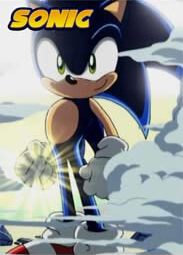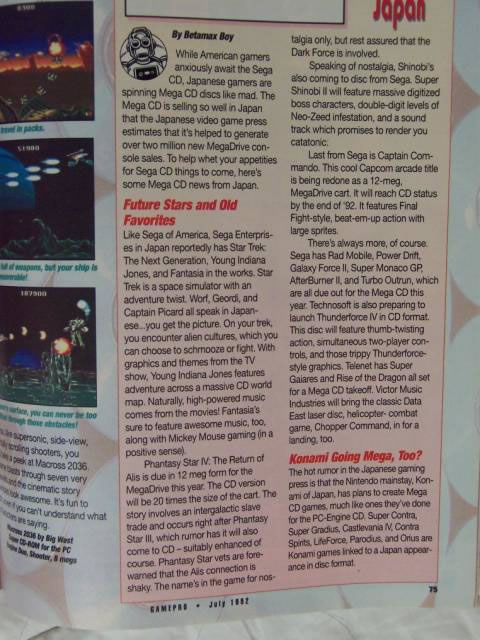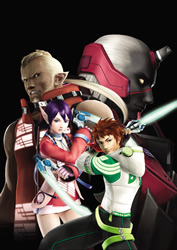I’m all for innovation and change. I understand that as time passes, companies have to adjust to meet new market demands. This is a fundamental part of the business and something all software developers have to deal with. As new gamers enter the fold, you have to cater to their tastes and styles by offering products that interest them. Gaming evolves, as Genesis fans well know. One need only look to the fading popularity of the side-scrolling mascot platformers of old to see that nothing lasts forever. Furthermore, some genres, like the 2D shmup, never really ever catch on, even after decades in the market place. Hardcore gamers surely love them, but the general masses have their eyes placed elsewhere.
 That’s may well be the case, but there is another aspect of the business that companies have to take into account. Many titles develop fan bases over the years that eat up each new installment with eager anticipation, and software houses need to periodically toss them a bone. At least that’s the way fans see it. Many developers see things differently, and a devoted following doesn’t always equal a killing in sales. For this reason, each new release is viewed as a way to bring new gamers into the fold or to jump start a sagging franchise.
That’s may well be the case, but there is another aspect of the business that companies have to take into account. Many titles develop fan bases over the years that eat up each new installment with eager anticipation, and software houses need to periodically toss them a bone. At least that’s the way fans see it. Many developers see things differently, and a devoted following doesn’t always equal a killing in sales. For this reason, each new release is viewed as a way to bring new gamers into the fold or to jump start a sagging franchise.
Sega knows this, to an extent. For years, they’ve been giving us new entries in many of their brands, like Sonic, OutRun and the recently departed NFL series (R.I.P. in my friend; you will be missed). There have been a few bumps in the road, to say the least, but we could always count on that next game to hopefully set things straight and give us the experience we all want.
Except, it isn’t that way all the time, and little by little, Sega seems to be changing direction with a few of their key franchises. Over the last few years, I’ve seen more and more big profile games from the House That Sonic Built head off from their traditional formulas, and I must admit that I’m a bit worried, especially since those franchises involved either got their start on the Genesis or reach prominence on it.
Shake, Shake, Shake
Take Shining Force NEO, for instance. A great game, no doubt about it. Solid presentation and fun hack-‘n-slash action makes it a worthy release by Sega. I have no problem with that at all. I do take issue, however, with the use of the Force name. As great a title as NEO may be, it has virtually nothing in common with Sega’s premier strategy/RPG series. In fact, with the exception of a few shared healing items, the name is all they really have in common. Why would Sega tag the Force brand onto a game that is the total opposite of everything those games represented? Wouldn’t it have made more sense to use the Shining part of the name, along with a new title? That’s what they’ve always done with this series, and the original Shining Force was itself the first deviation from the original formula, which made its debut in the classic Shining in the Darkness. The difference was that both games shared a common universe, villains and all. That was something each subsequent entry made a point to include.
Could this mean that Sega was planning to pull a Square/Enix with one of its most important brands? Was it possible that this would mean that future games would only share a name and nothing more? Maybe not since all of Sega’s other Shining offerings this generation have stayed close to home. Both Shining Tears and the Soul games all remained part of the classic continuum, so maybe NEO was just an experiment. After all, Shining Wisdom wasn’t all that close to its siblings in this regard, so maybe Sega was just trying to stir things up a little.
The problem is that they used one of their most well-known brands to do the stirring. Few people appreciated the Force moniker on NEO‘s cover, and anyone will tell you that they would have preferred a new entry in the classic formula over it or even a rerelease of the Saturn’s stellar Shining Force III (all three episodes, please!).
Burn Baby, Burn!
I may be jumping to conclusions a bit regarding the Shining games, but one place where there can be no denial of a beloved Sega brand skewing off into a questionable tangent is with Phantasy Star. What was once the premier RPG series in the company’s stable and an epic juggernaut that went toe-to-toe in fanboy arguments with Square’s own Final Fantasy line has been morphed into a quasi-MMORPG that still leaves gamers wondering what to think.
 The roots of the franchise’s transformation go back as far as 1993, when the Sega CD was a shiny new toy for people to spend their holiday wads on. It was announced that the next sequel would take place right after Phantasy Star III, and would feature the return of Alis Landale, who comes back to take on an interstellar slave trade. It was supposed to have been 20 times larger than part three and was to include a full CD soundtrack and anime cut scenes. It was eventually canned, along with several other desperately wanted ports (check out the 1992 news clip to the left and weep). The cartridge version of Phantasy Star IV prominently featured the blurb The Explosive Finale! on its cover, as though Sega were telling fans to cease their collective whining. It appeared that the series was all but done for.
The roots of the franchise’s transformation go back as far as 1993, when the Sega CD was a shiny new toy for people to spend their holiday wads on. It was announced that the next sequel would take place right after Phantasy Star III, and would feature the return of Alis Landale, who comes back to take on an interstellar slave trade. It was supposed to have been 20 times larger than part three and was to include a full CD soundtrack and anime cut scenes. It was eventually canned, along with several other desperately wanted ports (check out the 1992 news clip to the left and weep). The cartridge version of Phantasy Star IV prominently featured the blurb The Explosive Finale! on its cover, as though Sega were telling fans to cease their collective whining. It appeared that the series was all but done for.
Fast forward to 1999 and the debut of Sega’s final console, the Dreamcast. A new Phantasy Star game is announced! Oh joy! Oh happy day! Oh…wait. It’s an online multi-player action/adventure game? Not at all what we were expecting. The first console game of its kind, dubbed Phantasy Star Online, was radically different from anything else in the series. Now an almost entirely online experience, the standard turn-based RPG gameplay in the Algol Star System had been replaced by something that required a few friends to fully enjoy. It made the rounds on the Xbox and GameCube, got a sequel, and that was that. Just another experiment, right? Ol’ Yuji Naka trying to get the creative juices flowing for the real sequel we all knew was coming, right? RIGHT?
Nope, nah-ah, negative my friend. This was the new face of Phantasy Star and Sega only cemented this message by altering the formula even more. Enter Phantasy Star Universe, which is slated to appear in Japan in February on both the PlayStation 2 and PC. It boasts a new solar system, new characters, and classes; all of which make it seem to be the next logical step for the Online series than the traditional games. Sega still teases us by including classic weapons and several deliberately vague allusions to the original universe, something highly resented by many longtime fans. It’s almost as if they’re saying we know you want it, but you’re not going to get it. Take this, and like it, as it’s all you’re going to get. Remember that big blurb on the cover of Phantasy Star IV? Well, it’s now a full-blown slap in the face.
Not that I didn’t like the Online games. I put 400+ hours into both the Dreamcast and Xbox versions. What I didn’t like was that this wasn’t a side story to the original series. You know, a little something to nibble on while Sega cooked up the next epic RPG. This was it, the new direction for the franchise, and the old games were only something to refer to with almost politician-like spin whenever questions about continuity came up. We all know that Sega is run by two chimps with a yo-yo, but I still expect more than this from our simian friends in charge. Their determination about reinventing Phantasy Star was unwavering back in 1999, and Naka was pretty proud of his new baby. Still, the question remained: why would you start from scratch with an established franchise right when RPGs were finally taking off? I remember asking myself this very question, even as I played through PSO. Check out what Naka had to say to Famistu back in October of 1999:
Famitsu: Now I’ve heard that PSO takes place around the same time as Phantasy Star 4, and is similar in many aspects…
Naka: Hmmm….instead of calling it like that, it’s closer if you call it a side story. While it takes place in the same world, its system is completely different, as well as a completely different story.
Six years later, and we’re still waiting for him to explain how it all fits together.
Honestly, Sega has missed the boat with this brand so many times over the last decade, it’s almost as if they were slowly trying to wipe out all remnants of the first four carts. Sometime after 1994, Phantasy Star became the Terry Shiavo of the gaming world and Sega basically started saying that it can’t take care of it anymore and wanted to move on. A smart decision? Opinions vary, and I for one, am not convinced it was. There is still a marked for these classic RPGs, and there’s no doubt in my mind that a fifth Phantasy Star would have been successful. Apparently, both Square and Enix are aware of this, hence the continual releases of their star lines. After all these years, we still get regular sequels to both Final Fantasy and Dragon Quest. Some would say that this has gone on for too long, and people are even complaining that Dragon Quest VIII is too retro for its own good!
Here Today, Changed Tomorrow
I’m sure that many gamers today disagree with my assertion, and that’s fine. By the same token, I’m sure that there are many who feel the same as I do. My question here is: why can’t we have both? Sega has been giving us both 2D and 3D Sonic games for years, so why not the same with the Shining series and Phantasy Star? One cannot dismiss how ironic it is that the classic 2D Sonics have consistently been better than the 3D console releases, and I think Sega and the judgment-impaired Sonic Team are the only ones not seeing it.
 Sega can give me all the new and innovative games they want (another Samba De Amigo would be nice), but when they begin to tamper with something as renowned as the two aforementioned franchises, people tend to get grumpy. This generation has seen a lot of changes to Sega classics (Shinobi), and there have been some scary moments (Sonic Heroes. Seriously, what was that all about?). For example, I’m sure I wasn’t the only one wondering what was going on with the new version of VectorMan that was announced for the PlayStation 2 and then canceled.
Sega can give me all the new and innovative games they want (another Samba De Amigo would be nice), but when they begin to tamper with something as renowned as the two aforementioned franchises, people tend to get grumpy. This generation has seen a lot of changes to Sega classics (Shinobi), and there have been some scary moments (Sonic Heroes. Seriously, what was that all about?). For example, I’m sure I wasn’t the only one wondering what was going on with the new version of VectorMan that was announced for the PlayStation 2 and then canceled.
It’s debatable whether the new directions are a blessing or a curse and to be fair, Sega has recently delivered classic old school loving in the form of OutRun 2, Gunstar Super Heroes and Sonic Rush. All are wonderful games, and I only wish they could apply this philosophy equally to their entire catalogue. No one knows why they haven’t, but one thing is certain: time will tell just how far the fan’s loyalty will go.
Sources
- Famitsu Weekly. Yuju Naka Interview. Translated by WooJin Lee. RPGFan.com. October 17, 1999.
- Pettus, Sam. Sega CD: A Console too Soon. SegaBase. May 15, 2000.

Recent Comments